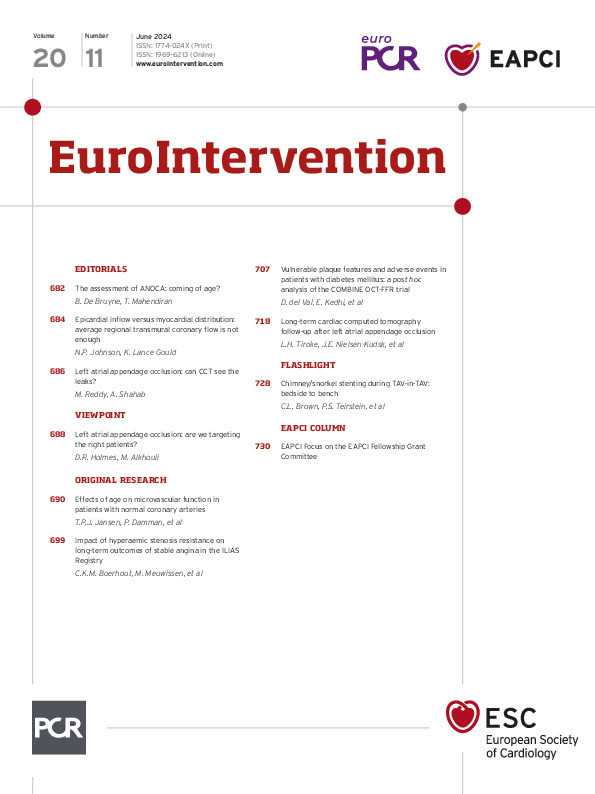Left atrial appendage occlusion (LAAO) has emerged as an effective stroke prevention strategy in non-valvular atrial fibrillation (AF), revolutionising the approach to high bleeding risk AF patients. Device-related thrombus (DRT) and significant peridevice leakage (PDL) remain major postprocedural concerns and have been studied in the short and intermediate term.
Historically, small PDLs were noted to be common in landmark trials, with the presence of any PDL ranging from 8.4% to 53.9% at 45 days12. Moderate and severe PDLs (≥3 mm diameter jet) were associated with worse outcomes and were more likely to persist compared to smaller PDLs34. Both size and incidence were found to have a temporal variation after LAAO3. In the PROTECT AF trial, the incidence of PDLs of any size decreased from 40.9% to 32.1% in 1 year, while the Amulet IDE trial noted that PDL ≥3 mm decreased from 25.9% to 21.7% in the WATCHMAN (Boston Scientific) arm and 11.2% to 9.5% in the Amulet (Abbott) arm over 1 year as well14. Most prior studies have focused on follow-up imaging at 1 year while continuing to track clinical outcomes for longer periods of time.
In this issue of EuroIntervention, the study by Tiroke et al adds to our knowledge by evaluating PDLs and DRTs after >4 years with follow-up imaging5. The authors included patients who underwent Amulet device implantation, and PDL was defined based on cardiac computed tomography (CCT) imaging. They graded PDLs based on a previously described classification involving the device disc, lobe and LAA contrast. The authors noted that the incidence of grade 1 (G1) and grade 2 (G2) leakage were stable in the 2-month, 12-month and >4-year CCTs. However, there was a statistically significant increase in the incidence of grade 3 (G3) leakage over time: 1.9%, 7.4% and 11.5% from the 2-month, 12-month and >4-year CCTs, respectively. The authors propose that this increase in PDL G3 is likely due to the increase in the left atrial volume over time, which they also noted in their study. The authors also evaluated hypoattenuated thickening (HAT) changes over time. They noted that none of the patients had high-grade HAT (DRT), and the incidence of low-grade HAT (presumed endothelialisation) increased from the 2-month to 12-month CCTs (11.5% vs 40.4%), but there was no increase from the 12-month to >4-year CCTs. The incidence of stroke/transient ischaemic attack was low in the study patients and did not correlate with the PDL grading.
Many of the findings in this study are in line with previous studies. CCT-based identification correlated with a higher detection of PDLs compared to transoesophageal echocardiograms (TOE) in prior studies, but it had poor correlation in terms of leak sizing67. At this time, the clinical significance of the higher frequency of PDLs detected via CCT is uncertain. In the current study, the incidence of PDLs were high – seen on about 65% of CCTs at all intervals. The authors need to be congratulated for reporting PDLs with >4 years of follow-up imaging. The authors noted that PDLs remain stable in terms of size, with only larger leaks (G3) noted as increasing in size over 4 years. This is likely due to the inability to endothelialise larger gaps, as compared to smaller PDLs, which are noted as regressing in other studies38. It is a little surprising that the authors did not see a decrease in smaller PDLs over this long follow-up period.
A recent meta-analysis by Samaras et al noted a graded association of thromboembolic events across PDL sizes measured by TOE but not those measured by CCTs9. The grading strategy applied by Tiroke et al also did not note any association between PDL and risk of thromboembolic events; although the small sample size and low event rate precludes any meaningful statistical association. Larger studies are needed to evaluate the utility of a CCT-based PDL grading system in predicting thromboembolic events.
There were no DRTs noted in this study. This is a surprising finding and may be related to the small sample size and selection bias. Patients were identified based on the availability of 4-year CCT, which could represent a healthier patient population. We would expect a higher rate of detection of DRT with CCT imaging performed given the detection of HAT and an improved image resolution. Alkhouli et al had previously noted that the pooled incidence of DRT was 3.8% across various LAAO devices, although studies with newer device iterations will likely show an improvement in incidence10.
The results of this study provide food for thought. Should there be greater adoption of CCT as a more cost-effective and less cumbersome imaging modality for post-LAAO screening? Use of CCT will lead to a greater detection of PDLs, but clinicians will have less certainty about the risk of thromboembolism than TOE-detected PDLs, especially for G1 and G2 PDLs. A proposal can be made to use CCT as a screening imaging modality after LAAO and to consider TOE when a G3 PDL is identified. A TOE-delineated LAAO PDL can be used to define the treatment strategy including continuation of anticoagulation for interventional PDL closure. The most encouraging conclusion from this study is that dual occlusive mechanism devices appear durable over a prolonged period; they maintain their effectiveness and will likely stand the test of time.
Conflict of interest statement
The authors have no conflicts of interest to declare.

